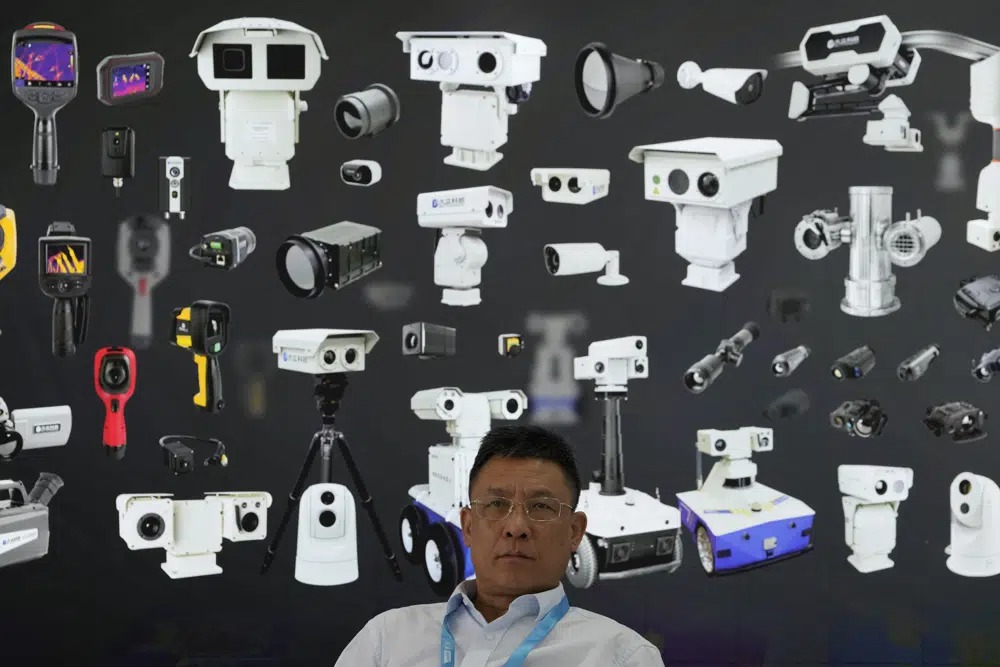After years of breakneck growth, China’s security and surveillance industry is now focused on shoring up its vulnerabilities to the United States and other outside actors, worried about risks posed by hackers, advances in artificial intelligence and pressure from rival governments.
The renewed emphasis on self-reliance, combating fraud and hardening systems against hacking was on display at the recent Security China exhibition in Beijing, illustrating just how difficult it will be to get Beijing and Washington to cooperate even as researchers warn that humankind faces common risks from AI. The show took place just days after China’s ruling Communist Party warned officials of the risks posed by artificial intelligence.
Looming over the four-day meet: China’s biggest geopolitical rival, the United States. American-developed AI chatbot ChatGPT was a frequent topic of conversation, as were U.S. efforts to choke off China’s access to cutting-edge technology.
“This new technology contains a great potential danger,” said Fan Weicheng, Director of Tsinghua University’s Center for Public Safety Research. He clicked through a presentation featuring an AI-generated figure of Barack Obama speaking, illustrating the risks of deceptive images and video that can now be digitally created.
“The United States has a 21st century national security strategy. Russia has a national security strategy. Germany has a strategy. So does Japan,” Fan said. “We in China are also working on this.”
Chinese academics, Fan says, are working on an “early warning system” to identify and manage potentially disruptive technology, creating indexes and formulas to measure the impact emerging technology could have on China’s national security.
In the past decade, China’s AI technology has made rapid advances, fueled in part through cooperation with American research institutes and tech firms. As in the U.S., Chinese leaders are worried about advances in artificial intelligence.
But there’s an additional challenge. As geopolitical tensions have reached a fever pitch in recent years, Washington has moved to cut China’s access to American technology — pushing Chinese tech firms towards self-reliance.
Remarks from a meeting chaired by Chinese leader Xi Jinping last month urged a renewed focus on potential risks from new technologies.
“The complexity and severity of national security problems faced by our country have increased dramatically,” said a readout of the meeting by the official Xinhua news agency. “We must be prepared for worst-case and extreme scenarios.”
China needs to develop locally-made products and become self-reliant, while keeping an eye on new developments coming out of the West, exhibition-goers said.
“It’s the AI era. The future has arrived,” said Liu Caixia, a director at a Chinese policing research institute. “Those in the academic community are feeling fear.”
“We’ve seen in some sci-fi blockbusters, there’s only intelligent machines left in the world, and human beings are kept like pets,” said Liu. “What kind of attitude should we adopt to deal with it?”
Liu’s answer was clear and in line with China’s determination to lead in cutting edge technologies: Push forward, and deploy AI in new fields.
But it also reflects a contradiction between China’s technology ambitions and deepening concerns about the possible social and political risks of such technologies. China’s tech firms have approached chatbots like ChatGPT with caution, for example, because of heavy censorship, having AI generate politically sensitive content is a no-go.
But ChatGPT begs the question: Should China rush to embrace AI and possibly fall prey to its pitfalls, or tiptoe cautiously and risk falling behind the United States?
Across the Pacific, American tech executives and policymakers are grappling with the same questions. Waves of U.S. sanctions have targeted Chinese chipmakers and AI companies to restrict Beijing’s access to cutting-edge technology. Politicians worry about China’s growing prominence in the field.
With Sino-U.S. frictions at a boiling point, Secretary of State Antony Blinken visited Beijing this week to stabilize ties, seeking to assure Chinese counterparts that Washington was not looking to decouple from China – only “de-risk and diversify.”
Though both sides declared the trip a success, Beijing expressed frustration with U.S. sanctions, with China’s top foreign affairs official Wang Yi demanding the U.S. “abandon suppression of China’s technological development.”
Some experts believe cooperation, not conflict, is necessary to confront what they see as a threat to all humanity. Earlier this month, OpenAI CEO Sam Altman dialed into a conference hosted by the Beijing Academy of Artificial Intelligence to encourage collaboration between Chinese and American researchers to mitigate the risks of AI.
“The stakes for international cooperation have never been higher,” Altman said, noting that China was home to some of the world’s top AI researchers. “We must manage the risk together.”
Such concerns were mirrored at the conference in China, where executives expressed concern about the potential for AI-generated voice and imagery to be used in fraud, hacking, and disinformation campaigns.
“The potential for fraud is very high,” said Li Congting, chief AI scientist at video surveillance manufacturer Uniview. “Many people have already played around with ChatGPT. Everyone thinks its ability to interact is really good, like there’s a real person behind it.”
Scientists and tech industry leaders in the U.S., including high-level executives at Microsoft and Google, recently warned about the potential perils of artificial intelligence.
Many Chinese researchers echoed those concerns. But at the Beijing expo, there was little talk of cooperation with the United States.
“Tech innovation has become the main battlefield of international geopolitics,” said Gao Lei, a top official at a state-run enterprise managed by China’s Ministry of Public Security. The US has “escalated its suppression” of China’s tech industry, Gao said, saying it was “imperative” to replace American technology with local computer chips.
Though both countries grapple with concerns about AI, stark differences in their approaches to the technology make cooperation difficult.
China has built one of the most intrusive digital surveillance systems in the world, blanketing city streets and rural villages with cameras and tracking citizens through chat apps and mobile phones.
The U.S. government has sanctioned many Chinese tech companies for their role in Beijing’s high-tech crackdown in China’s far west Xinjiang region, where digital technology was used to flag ethnic minorities for arrest on often spurious grounds.
Many of the companies at the expo had been sanctioned, including telecoms giant Huawei, camera-maker Hikvision and surveillance specialist Meiya Pico. A representative for Meiya Pico declined an interview with The AP, citing a blanket ban on speaking with foreign media.
Use of policing technology in the U.S. is constrained by civil society and legal challenges. But that has not prevented many from deploying questionable privacy-infringing tech including facial recognition and predictive policing, feeding charges of hypocrisy and fueling suspicions in China that U.S. sanctions are politically motivated.
Meanwhile, Chinese companies are continuing to deploy technology in ways that Western lawmakers find concerning.
At the conference, one China Mobile researcher discussed drones his company was providing to the Hong Kong police. They were used to monitor protesters during 2019 anti-government protests, the researcher said. Advances in 5G telecommunications technology mean officers no longer need to pilot the drones in the field, but can do so from the comfort of their offices.
“With the click of a mouse, they can get drone footage from the field sent to their computer,” said the researcher, Su Yu. “This improves efficiency.”
With tensions at an all-time high, experts say, it’s an open question whether the two countries can find a way to work together.
“How do the U.S. and China coexist with such fundamentally different norms around the use of technology and society?” said Samm Sacks, a senior fellow at Yale Law School studying Chinese tech policy. “We have to find a way forward. Politically, it is not going to be easy to do.”
(AP)











